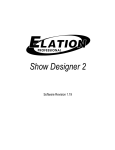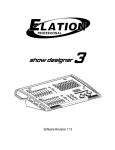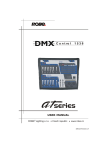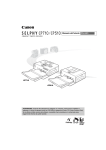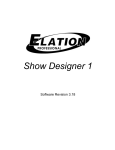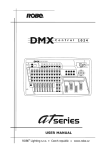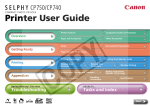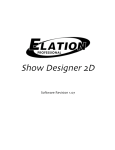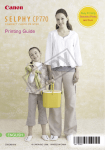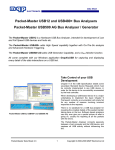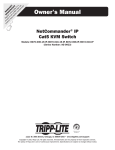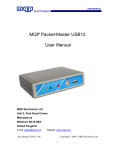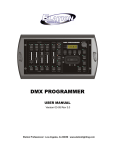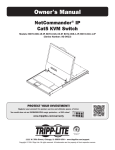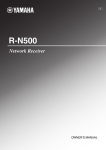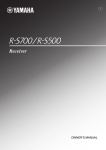Download Show Designer 2CF User Manual v1.20
Transcript
Show Designer 2 Software Revision 1.20 OVERVIEW ................................................................................................................................................................................1 REAR PANEL CONNECTIONS ............................................................................................................................................1 FRONT PANEL.......................................................................................................................................................................1 MENU AND SETUP FUNCTIONS ...........................................................................................................................................2 CHOOSE FIXTURES .............................................................................................................................................................2 PATCH FIXTURES .................................................................................................................................................................2 MULTI FIXTURE ...................................................................................................................................................................3 MODIFY FIXTURE................................................................................................................................................................3 COPY FIXTURE .....................................................................................................................................................................5 PAN AND TILT INVERT .......................................................................................................................................................5 ADJUST FACTORY CHASES ...............................................................................................................................................5 SELECT HOME SCENE ........................................................................................................................................................5 SET MIDI CHANNEL ............................................................................................................................................................5 VIEW MEMORY SIZE ...........................................................................................................................................................5 SAVE MEMORY FILE TO CF ...............................................................................................................................................6 SAVE MEMORY FILE TO COM PORT ................................................................................................................................6 LOAD MEMORY FILE FROM CF ........................................................................................................................................6 LOAD MEMORY FILE FROM COM PORT ........................................................................................................................6 LOAD FIXTURE PROFILE FROM CF ................................................................................................................................6 LOAD FIXTURE PROFILE FROM COM PORT .................................................................................................................7 REMOVE FIXTURE PROFILE .............................................................................................................................................7 UPDATE SOFTWARE ............................................................................................................................................................7 LOCK/UNLOCK MEMORY ..................................................................................................................................................7 ERASE ALL MEMORY..........................................................................................................................................................7 SWITCHES AND CONTROLS..................................................................................................................................................8 NUMBER SWITCHES 1-48 ...................................................................................................................................................8 FIXTURE ................................................................................................................................................................................8 FIXTURE GROUP ..................................................................................................................................................................8 DATA WHEELS ......................................................................................................................................................................8 CHANNEL FADERS ..............................................................................................................................................................9 BANK SWITCH......................................................................................................................................................................9 JOYSTICK ..............................................................................................................................................................................9 FINE SWITCH ......................................................................................................................................................................10 BLACK SWITCH .................................................................................................................................................................10 SCENES ....................................................................................................................................................................................11 CROSSFADE TIME..............................................................................................................................................................11 RECALLING SCENES (solo mode) ....................................................................................................................................11 RECALLING SCENES (add mode)......................................................................................................................................12 RECALLING SCENES (preview mode) ..............................................................................................................................12 RECALLING SCENES WITH SCENE MASTER FADERS ..............................................................................................12 ERASE SCENE .....................................................................................................................................................................12 PRESETS ..................................................................................................................................................................................12 FACTORY PRESETS............................................................................................................................................................13 RECORDING PRESETS ......................................................................................................................................................13 RECALLING PRESETS .......................................................................................................................................................14 ERASE PRESET ...................................................................................................................................................................14 EDITING PRESETS .............................................................................................................................................................14 COMBINING PRESETS ......................................................................................................................................................15 CHASES ....................................................................................................................................................................................15 RECORDING CHASES .......................................................................................................................................................15 RECALLING CHASES ........................................................................................................................................................16 ERASE CHASE ....................................................................................................................................................................17 EDITING CHASES ..............................................................................................................................................................17 FACTORY CHASES .............................................................................................................................................................17 AUDIO SWITCH ..................................................................................................................................................................18 BEAT SWITCH .....................................................................................................................................................................18 SHOWS .....................................................................................................................................................................................19 ii RECORDING SHOWS .........................................................................................................................................................19 PLAYING SHOWS ...............................................................................................................................................................20 ERASE SHOW ......................................................................................................................................................................21 EDITING SHOWS ................................................................................................................................................................21 PREVIEW .................................................................................................................................................................................21 SCENE MASTERS ...................................................................................................................................................................22 HOW THE SCENE MASTERS WORK ...............................................................................................................................22 MIDI ..........................................................................................................................................................................................23 USING THE COMPACT FLASH INTERFACE ......................................................................................................................23 MEMORY BACKUP ............................................................................................................................................................24 MEMORY RESTORE ...........................................................................................................................................................24 SOFTWARE UPDATE ..........................................................................................................................................................24 SOFTWARE UPDATE USING AUTO LOAD.....................................................................................................................24 FIXTURE PROFILES ...........................................................................................................................................................25 USING THE COM PORT .........................................................................................................................................................25 MEMORY BACKUP USING THE COM PORT .................................................................................................................25 MEMORY RESTORE USING THE COM PORT ................................................................................................................25 LOAD FIXTURE PROFILE .................................................................................................................................................26 iii OVERVIEW The Show Designer 2 is a lighting controller based on the successful and simple to use Show Designer 1. The Show Designer 2 offers all of the same features and much more. It is designed to simplify the programming process as much as possible while still offering lots of power at a low cost. You can control 48 DMX 512 lighting fixtures of up to 32 channels each from two DMX 512 universes. If you are controlling smaller lighting fixtures that use fewer than 32 channels each, you will be able to control more than just 48 fixtures. You can control as many fixtures as will fit within the two DMX 512 universes. The SD2 supports all popular brands of DMX 512 lighting fixtures. Libraries of fixtures are available for download at elationlighting.com. REAR PANEL CONNECTIONS • Power input - uses an external 9V power supply. This requires a transformer with a 9VDC output at 500ma. The plug polarity is + center with an inside diameter of 2.1 mm. • Two DMX 512 outputs - each with a 3 pin and a 5 pin XLR connector. There is a polarity switch for the 3 pin XLR which swaps pins 2 and 3. Some older lighting fixtures require this. The more commonly used and correct DMX 512 polarity is data minus on pin 2 (switch is to the right as you’re looking at the back of the unit). • MIDI in and out - used for calling scenes in an automated installation. • 9 pin RS-232 connector - used for connection to a PC. • Keyboard - used to attach a PC keyboard for data entry. This supports a PS2 keyboard. • Audio input - used for syncing chases to an external audio source. This is a line level input for connection to the output of a mixing console. Do not connect speaker level signals to this. • Compact flash connector - This allows you to back up the memory, load lighting fixture profiles or update the software using compact flash memory cards. FRONT PANEL Front panel features include assorted switches for programming, eight 60mm faders for direct control of lighting fixture channels as well as for scene masters, four wheels for channel control and data entry, a joystick for pan and tilt control and a backlit display for programming. There is also a 3 pin XLR connector for a work light. i MENU AND SETUP FUNCTIONS The menu switch, which is located above the character display, is used to configure the Show Designer 2 for your particular lighting setup. The left and right cursor switches, the + and switches, and the data input wheels allow you to select settings for the various menus that appear on the display. Pressing the menu switch displays the message “Select a menu item then press enter” on the top line of the display. You will be given a choice of menu items on the bottom line of the display. You can cycle through the choices using the + and - switches or the #1 data wheel. Press “enter” to select the desired menu item. After selecting from the menu, the cursor switches will allow you to select a field on the display to edit and the + and - switches will allow you to change the value in that field. An underline cursor shows the selected field. You can also use one of the four data wheels under any field to make changes. (The wheels don’t require you to select a field using the cursor switches). The “enter” switch must always be pressed following any change made to a menu item to make it permanent. This allows you to look at all of the possible choices first. Several of the menu choices are hidden to prevent unauthorized or accidental changes to the memory. The “memory lock/unlock” function is hidden as well as the “erase all memory” function. These choices can only be selected by pressing and holding down the “add” switch while selecting these last items from the menu list. This is a safety feature for the benefit of installers who wish to protect the memory from unauthorized tampering. The various menu items are explained in the following paragraphs. CHOOSE FIXTURES This allows you to select from a list of lighting fixtures in the fixture library. First use the + or switch or the #1 data wheel to select the fixture number (from 1 to 48), then select the type of fixture with the #2 data wheel or move the cursor to the fixture type and use the + or - switch. You must press “enter” to record the choice. You can also press “erase” to select “No Fixture”. If auto patch is enabled, a warning will appear telling you that some DMX start addresses may be changed. Press “yes” to confirm or “no” to exit. After pressing “yes” the message “DONE” will appear for 1 second. If auto patch is enabled, the start addresses of any fixtures above the selected fixture may be shifted to accommodate the new fixture. The Show Designer 2 has a short list of built in list of fixtures to choose from. You can also load in “fixture profiles” that contain more detailed information about a particular lighting fixture than what is offered by the built in list. Fixture profiles are small files that can be downloaded from elationlighting.com. They can then be loaded into the Show Designer 2 using the compact flash drive or through the RS-232 port. Read the section on loading fixture profiles for more information. When selecting fixtures from the “Choose Fixtures” menu, any fixture profiles that were loaded into memory with the compact flash will be followed by the word “profile” in the display. This is so that you can tell the difference between the built in fixtures and profiles. Use profiles whenever possible. PATCH FIXTURES This allows you to turn auto patch on and off or to change the output port and set the DMX starting address for each fixture manually. Auto patch must be turned off to manually change the start address or port of any of the fixtures. To turn auto patch on or off, place the cursor under the words “ON” or “OFF” below “AUTO PATCH”, then use the + or - switch or use data wheel #4 to change. You must press “enter” for the change to take effect. If you are turning ii auto patch on, a warning will appear telling you that some DMX starting addresses may change. Press “yes” to proceed or “no” to exit. Auto patch will assign an address to each fixture in ascending order. The first fixture will be assigned to DMX output port 1 at address 1. After 512 channels have been used, DMX output port 2 will be used for any remaining fixtures. With data wheel #1 you can select from fixtures 1-48 and see the starting address and port assigned to each fixture. You can move the cursor under any of the three digits of the channel number or use data wheel #3 to select a new starting address as long as auto patch is turned off. You must press “enter” to record any change. The message “DONE” will appear for 1 second to confirm. MULTI FIXTURE Show Designer 2 supports intelligent lighting fixtures that use as many as 32 DMX channels. Since most fixtures use fewer than 32 channels, Show Designer 2 will allow you to configure a group of smaller fixtures that are of the same type, under a single fixture number. For example if you have selected a 4 channel scanner for fixture number 1, you can set “multi” to 8. When fixture 1 is selected you will be able to use all 32 channels available for fixture 1 to control 8 of these scanners. NOTE: This feature is for controlling large numbers of small fixtures. This helps to prevent using up all 48 of your fixture numbers on small fixtures. You will be able to control the individual channels of each fixture separately using the 4 banks of 8 faders or with the data wheels. When using the joystick, all of the multi fixtures within that fixture number will respond if they have a pan and tilt feature. To control individual pan and tilt levels separately you will have to use the faders or the wheels. To program the multi fixture setting for a fixture number, use data wheel #1 to select a fixture. Use data wheel #2 to increment or decrement the multi value. You can only choose numbers between 1 and the maximum number of fixtures that will fit into 32 channels. For example, if you are using a 4 channel fixture the multi value can be no higher than 8. You must press “enter” to record the change. If auto patch is enabled you will be given the warning that some addresses may change. Press “yes” to continue or “no” to exit with no changes. MODIFY FIXTURE This allows you modify some of the channel attributes of a fixture. You can also use this to create a new fixture that isn’t in the library by modifying an existing one. To do this you must first select a fixture as described above in the “Choose Fixture” section. When trying to create a new fixture, choose something that is similar to the one you are trying to create or start with the “Generic Dimmer” which is the first choice from the list. You can later use the “Copy Fixture” feature as described in the next section to duplicate the new fixture. There are nine fixture attributes that can be modified. The attributes are: fixture name, number of channels, black channel, black value, pan channel, pan fine channel, tilt channel, tilt fine channel and crossfade mode. From the “Modify Fixture” menu, use data wheel #1 to select the fixture you want to modify. Next use data wheel #2 to select from the nine fixture attributes. Next use data wheel #3 to select the value for the attribute you are changing. Finally you must always press “enter” to record the changes you make to each attribute. The message “DONE” will appear in the display when the change has been recorded. The fixture attributes are described in the following paragraphs. NAME is the fixture name that appears whenever you select or deselect a fixture. You may want to modify this attribute for all of your fixtures to show fixture purpose or location. You iii must place the underline cursor on the character you want to edit or you can use the external keyboard to enter a fixture name. CHANNELS is the total number of channels used by the fixture. This can be any number from 1 to 32. When you change the number of channels, be aware that other things such as fixture addresses and number of multi fixtures can be automatically changed when you do this. Fixture attributes such as black channel, pan or tilt will also be automatically disabled if you select a number that is smaller than the channel numbers that are already assigned to those attributes. For example if you already assigned pan to channel 8 and you reduce the total number of channels for the fixture to 4, pan will automatically be set to “none”. Likewise if you increase the number of channels from 8 to 9 and you had previously set up 4 multi fixtures using all 32 channels, the multi fixture setting will automatically be reset back to 1. BLACK CHANNEL is the channel that will be affected when the “black” switch is pressed. You can choose any available fixture channel as well as “ALL” which will force all channels to the selected black value. BLACK VALUE is the DMX value that will be sent to the selected black channel(s). This will accommodate fixtures that use the gobo wheel for blackout and use a value other than 0 to set the gobo wheel to black. You may also want to blackout all channels to a value other than 0 since this is used as a reset by some fixtures. For some fixtures a value of 1 achieves the same result as a value of 0 for blackout. PAN CHANNEL is the channel used by the fixture for pan. This can also be set to “none” if the fixture does not have a pan feature. This is also the pan coarse channel or pan high byte channel for those fixtures that use two channels to control pan. This directs the joystick output as well as other pan functions such as factory chases. PAN FINE is for fixtures that use two channels to control pan. This is also referred to sometimes as the pan “low byte” channel. Set this to “none” if the fixture uses only one channel for pan. The joystick will control this channel with “fine” mode turned on. TILT CHANNEL is the same as described above for pan channel except that it controls tilt. TILT FINE is the same as described above for pan fine except that it controls tilt. FADE MODE is used to set the crossfade method for each of the fixture’s channels. Use data wheel #2 to select the channel. Once the channel is selected use data wheel #3 to select the crossfade mode. The choices are “crossfade”, “snap before fade” and “snap after fade”. You must press “enter” after each channel has been programmed. Selecting “Crossfade” will cause a channel to smoothly fade from one scene to another when changing scenes. The crossfade time will vary from scene to scene depending on how that scene was programmed. Use this setting for channels that control functions like pan and tilt or dimming to achieve a smooth transition from scene to scene. This is usually the default setting for pan, tilt and dimmer channels. If you use this setting for gobo or color wheel channels, it will cause the wheels to step through all positions between the start and end positions of a long fade. Selecting “Snap before fade” will cause the channel to jump immediately to the next scene level as soon as the new scene is called. Use this setting for channels that control motor speed so that pan and tilt will move at the correct speed during the fade. You can also use this setting for wheel channels that you want to change at the start of a long crossfade. This is usually the default setting for speed and mode channels. iv Selecting “Snap after fade” will cause the channel to jump immediately to the next scene level at the end of a crossfade. Use this setting for wheels and effects that you want to take effect after a long crossfade is complete. This is usually the default setting for color and effects wheels. COPY FIXTURE Use this to copy the fixture type and attributes from one fixture number to another. This feature saves time when setting up a group of fixtures that are all the same type by letting you copy a fixture rather than searching through the list each time. data wheels #1 and #2 to select a fixture number to copy from and to. You must press “enter” to complete the copy process. If auto patch is enabled you will be given the warning that some addresses may change. Press “yes” to continue or “no” to exit with no changes. If a fixture is already set up at the “copy to” location, you will be asked if you want to copy over the existing fixture, press “yes” to copy over it or “no” to exit. PAN AND TILT INVERT The joystick can be used to control pan and tilt when a fixture has a pan and tilt feature. Sometimes a fixture is oriented in a way so that its pan or tilt movement is opposite that of the joystick movement. You can use this to invert the direction of the pan or tilt for each fixture. This setting will not affect the faders or the wheels when they are used to control pan or tilt. From this menu, use data wheel #1 to select the fixture then use data wheels #2 or #3 to set the invert states for pan or for tilt. You must then press, “enter” to save the selection. ADJUST FACTORY CHASES Show Designer 2 provides 48 preprogrammed chases of pan and tilt movements that are referred to as factory chases. These are mostly circle movements and some other pan and tilt effects. Use this menu to adjust the pan and tilt centers of these chases. This is helpful when one of the circle chases is close to what you want but is not in the exact desired location. You can use this while the chase is running so that you can see the results as you make adjustments. First select the factory chase number (1-48) using data wheel #1 then adjust the pan or tilt offset using data wheels #2 or #3. The offset can be adjusted in a plus or minus direction. This menu does not require you to press “enter” to complete the change. Be aware that any scene that uses this factory chase will be affected by this adjustment. SELECT HOME SCENE This allows you to select a home scene that will be called automatically whenever you use the “clear all” function when holding down the “black” switch for 2 seconds. This can be used to call up a default lighting configuration such as all beams centered, full intensity at white when building a new scene. Use data wheels 1 and 2 to select the desired page and scene number then press “enter”. You must of course have a scene saved at that location for it to work. You can use any saved scene as the home scene. SET MIDI CHANNEL This allows you to select the MIDI channel that Show Designer 2 will send and receive on. Select from 1-16 using data wheel #1 then press “enter”. Read the section on MIDI for more info. VIEW MEMORY SIZE This allows you to see how much memory is left for scenes and shows. It is displayed in kilobytes remaining. Memory usage varies depending on the size and complexity of the scenes. v SAVE MEMORY FILE TO CF This allows you to back up the memory to a compact flash card. The message “Press enter to save file to CF” will appear on the top line of the display. The default file name will appear on the bottom line. You can use the data wheel or the external keyboard to enter a new file name. Insert a formatted CF card in the slot and press enter. The message “File has been saved” will appear when finished. The content of the entire memory is backed up including all menu settings, scenes, presets, chases and shows. The file will have the extension .sdm and is compatible with Windows as long as you adhere to Window’s file naming rules. The file name can use up to 8 characters. You do not need to add the extension when typing in the file name. Read the section at the end of this manual on using the compact flash for more information. SAVE MEMORY FILE TO COM PORT This allows you to back up the memory directly to a PC using the RS-232 port. While in this menu, pressing “enter” starts the data transmission. The contents of the memory are encoded in text format and can be recorded by a PC connected to the RS-232 port. Read the section at the end of this manual on using the computer port for more information on how to back up the memory this way. LOAD MEMORY FILE FROM CF This allows you to restore the memory from a backup. Pressing, “Enter” displays the message “Select memory file, then press enter” on the top line of the display. The name of the first Show Designer 2 memory file on the CF card will appear on the bottom line of the display, use data wheel 1 to select the desired file. Press, “enter” to load the file. Warning: the current memory will be overwritten. Read the section at the end of this manual on using the compact flash for more information. LOAD MEMORY FILE FROM COM PORT This allows you to restore the memory from a backup that was made using the RS-232 port and a PC. Pressing, “enter” configures the RS-232 port for memory read and waits for the file to be sent from a PC. Read the section at the end of this manual on using the computer port for details on how to back up and restore the memory this way. The only way to exit this menu is to turn the power off. LOAD FIXTURE PROFILE FROM CF This allows you to load fixture profiles into the Show Designer 2 from a compact flash card. Fixture profiles are small files that are available from elationlighting.com that contain detailed information about a lighting fixture such as the name and function of each of the channels as well as the name and DMX values of steps within a channel. Once loaded, a profile can be selected from the fixture list when choosing fixtures. Fixture profiles are most useful when using the data wheels to program lighting fixture channels. The display will be able to show the function and current setting for each channel. The wheels will be able to select preprogrammed steps within a channel such as the colors on a color wheel. These channel steps can also be accessed using presets (explained in more detail in a later section). The message “Select fixture file, then press enter” will appear on the top line of the display. The bottom line of the display will show the first fixture profile found on the disk, use data wheel 1 to select a profile (if there is more that one profile on the disk) then press “enter”. The profile will be loaded into memory and can now be selected using the “choose fixtures” menu. Up to 256 fixture profiles can be loaded into memory. vi LOAD FIXTURE PROFILE FROM COM PORT This allows you to load fixture profiles into the Show Designer 2 from a PC using the COM port. When this menu item is selected the message “Ready to receive fixture profile” will appear. You must send the fixture file from your PC to the Show Designer using the “SD backup” program available from elationlighting.com. Read the section later in this manual on how to use the computer port for more information on this topic. REMOVE FIXTURE PROFILE Use this to remove individual profiles from memory. When you enter this menu the message “Select profile to remove, press enter” will appear on the top line of the display. The first profile found in memory will appear on the bottom line, use data wheel 1 to select from the list of saved profiles. Press, “enter” to remove any selected profile. UPDATE SOFTWARE This lets you to update the software inside Show Designer 2 from a software update file on a compact flash card. If a CF card is inserted, the Show Designer 2 will search the card for the proper file and then install it. The message “RECEIVING NEW PROGRAM” will appear as the new software file is installed. Upon completion, the system will reboot. Read the section at the end of this manual on using the compact flash for more information. LOCK/UNLOCK MEMORY This is one of the hidden menu items that can only be selected while holding the “add” switch when cycling through the menu selections. This feature allows you to lock the memory to prevent someone from changing or erasing anything that has been recorded. The message “MEMORY LOCKED, CAN’T RECORD” will appear if the memory is locked and anyone presses the record switch. All other menu items will also be locked out in order to protect the memory. To lock or unlock the memory from this menu, use data wheel #1 to select the desired state, then press “enter”. ERASE ALL MEMORY This is another one of the hidden menu items that can only be selected while holding the “add” switch when cycling through the menu selections. This menu item allows you to clear the entire memory of the Show Designer 2. This erases the scene, preset, chase and show data as well as the system parameters such as fixture assignments. The message “ARE YOU SURE? HOLD “YES” 5 SEC” will appear in the display. Press and hold “yes” until the system reboots or press “no” to exit. vii SWITCHES AND CONTROLS The Show Designer 2 lets you to take direct control of lighting fixture channels at any time. There is no edit mode as with some lighting controllers. You are essentially always in edit mode and can instantly save the current stage settings as a scene. This is one reason the Show Designer is so quick and easy to program. The following paragraphs outline the various switches and controls with their functions. NUMBER SWITCHES 1-48 The large group of switches on the left side of the panel that are numbered 1-48 are multipurpose. The function switches that are just above these determine their purpose. Only one function is selected at a time and the LED for the particular function will be lit when selected. The following is a description of each function. The function switches can also be activated using the “F1 – F7” keys on an external keyboard. FIXTURE This switch lets you to select fixtures for programming. With the “fixture” switch LED lit, the number switches 1-48 are used to select an active fixture. When a fixture is selected it can be directly controlled using the faders, the wheels, the joystick or by selecting a preset. A fixture does not have to be selected to be controlled by scenes or shows. If a fixture is not selected it will only be disconnected from the manual controls, the fixture is not turned off. When a fixture is selected its name will appear in the LCD followed by the first 4 channels of the fixture along with the current values of those channels. The four data wheels can be used to adjust the levels or settings for each channel. Pressing the “fixture” switch at any time will enable the channel wheel display and the channel wheels. If a fixture profile is installed for a fixture the display will show the names of the channels as well as the current channel values as defined by the fixture profile. Use the left or right arrow switch to view the next group of four channels in the fixture. FIXTURE GROUP The fixture group switch lets you select combinations of fixtures with a single button press. To create a fixture group press “record” then “fixture group”, both LEDs will flash. Next press “fixture” to select which fixtures will be included in the group. Use the number switches to turn the desired fixture LEDs on or off. Next press the “fixture” switch again to turn off its LED. If you want to name the group, use the cursor switches to place the underline cursor under the character of the name and use the data wheel to select characters or use the external keyboard. Finally select the group number by pressing one of the number switches from 1-48. If a number switch LED is already lit it means that a group is already recorded there. After you are finished recording, press “record” to exit. Fixture groups are selected by pressing “fixture group” then selecting the desired group from 1-48. If you want to turn on more than one group you must hold down the “add” switch while selecting. To edit a fixture group, first select the group then press “record” and proceed as described in the preceding paragraphs. Make any changes to the group then resave it. DATA WHEELS The data wheels are used to increment or decrement the values in the display fields directly above each wheel. They are used for adjusting the channel values of the lighting fixtures as viii well as for general-purpose programming. Pressing the “fixture” or “fixture group” buttons will bring up the channel display if there are any fixtures selected. You can view and adjust 4 channels at a time using the 4 wheels, and you can access more channels by pressing the left or right cursor button. Because only one fixture can be displayed at a time, the last selected fixture will be the one displayed when more than one fixture has been selected. If a “fixture group” is selected, the lowest numbered fixture in the group will be displayed. NOTE: When more that one fixture is selected, only fixtures of the same type that match the fixture in the display will be affected by the wheels. This assures that the display matches the fixtures being edited. Show Designer 2 will display the channel names for most fixtures that are in the built in library. If a fixture profile has been installed, some channels can display the names of each step within the channel, like color and gobo names. Use fixture profiles instead of the internal fixture library whenever possible. CHANNEL FADERS Just below the number switches are 8 faders that can also be used to control the individual channels within a fixture. You can address up to 32 channels per fixture by using 4 banks of 8 faders. The bank switch to the left of the faders is used to select which bank of 8 channels is currently active. The LED to the left of the faders shows the current bank. The channel numbers controlled by the faders are printed to the left of each fader. For example the first fader can control channels 1, 9, 17 or 25 depending on which bank is selected. If a fixture has less than 32 channels then some banks and some faders will not be used. Before the channel faders can control a fixture, that fixture must be selected. Any number of fixtures can be controlled at once. If for example all fixtures are enabled, moving fader 1 with bank 1 selected will change channel 1 on every fixture. If you are using the “multi fixture” feature of Show Designer 2, the channel faders can be used to control each channel of every fixture within the multi fixture group. If for example you have programmed 8 fixtures having 4 channels each, faders 1-4 will control the first fixture of the multi fixture group, faders 5-8 the second and so on. The faders can also be used as scene masters. This is explained in more detail in the next chapter. BANK SWITCH The bank switch selects the current bank of channels controlled by the 8 faders. This allows you to control up to 32 channels per fixture (or 32 scenes when in scene master mode) using only 8 faders. The bank LED next to the faders will show the currently selected bank and the numbers printed next to each fader show the channel number or scene number of the fader for the selected bank. As a convenience the bank select will only go as high as needed for the size of the currently selected fixtures. JOYSTICK The joystick controls pan and tilt on all selected fixtures that have a pan or tilt feature. The joystick is the “return to center” type so it operates by moving it in the desired direction. The greater the joystick movement the faster the pan or tilt movement will be. The state of the “fine” mode switch also determines the speed of the pan or tilt movement. If a fixture uses two channels for pan or tilt (16 bit), the joystick will affect the fine channel with “fine” mode on. If the fixture only uses 1 channel for pan or tilt, the movement will be slower allowing more precise control with “fine” mode on. ix FINE SWITCH The fine button affects the way the joystick and the data wheels operate. With fine mode on, they will increment or decrement by the smallest possible amount. With fine mode off, they will increment or decrement by larger amounts. If a fixture profile is installed for a selected fixture, selecting fine mode will switch the channel wheel display to number values instead of name values such as color or gobo names. This can be useful for splitting colors or gobos. BLACK SWITCH Pressing the “black” switch will stop all activity and blackout all fixtures. Depending on the type of fixture and its capabilities, black will only turn off the channel that controls the output of the lamp but for some types of fixtures will set all channels to 0. The “black” LED will remain on to indicate that a blackout was called. Pressing the “black” switch a second time will turn the LED off and restore the blacked out channels to their previous settings. Clear All: Pressing and holding the “black” switch for 2 seconds will force all DMX channels to 0 and clear the scene buffer. This function is useful when programming new scenes. You can also select a starting or “home” scene that will be called whenever you use this function. Refer to the menu section of this manual under “Select Home Scene” for instructions on how to do this. You can use any scene that you have already saved as the home scene. x SCENES A “scene” is a recording of the state of the entire stage. Show Designer 2 keeps track of all the actions you take to make the stage appear as it does. Anything that affects the look of the stage such as changing channel levels, calling a chase or calling a preset, is recorded in the scene buffer so that you can save these things as a scene. This method of scene programming lets you edit existing scenes quickly. Just call a saved scene, change something and resave. Once you have a look on stage that you want to save as a scene, press “record”, its LED will flash. Next press “scene”, its LED will also flash. The page display will light and any number locations that already contain scenes will also light. You can at this time enter a name for the scene as well as a crossfade time. Use the cursor switches to move the cursor under each character of the name, then use the + or - switch or data wheel #1 or #2 to modify the name characters. Use data wheel #3 to set the crossfade time. You can also use an external keyboard to enter the scene name or to enter the fade time. To finish recording the scene, select the page and scene number. You can use the page switches to select from pages 1 to 99 and the number switches from 1 to 48 allowing you to store up to 4752 scenes. If you select a scene number that is already lit, a message will appear asking if you want to write over the existing scene. Press “yes” or “no”. If at any time you wish to exit record mode without recording anything, press the “record” switch and you will exit record mode. Note: It can take several seconds to overwrite or erase a scene depending on how much memory is currently used. CROSSFADE TIME When you record a scene you must select a crossfade time for the scene. This sets the amount of time it will take to transition when it is played back. You can set the fade time to 0 if you want the scene to take effect instantly. You can set scene fade times up to 25 seconds long. During the fade, some fixture channels will transition to their new settings gradually while others will snap to their new positions either at the start of the fade or at the end. Channels that control beam movement and dimmer levels are typically set to fade gradually while channels that control color or beam appearance are set to snap at the end of the fade. This behavior is defined in the fixture library for each fixture channel. You can override the default settings for any of your fixture channels by using the “modify fixture” menu. Refer to the Menu chapter under “modify fixture crossfade mode” for more info. When you call a scene that has a chase in it, the chase will start right away regardless of the fade time. Presets included in the scene will either fade or snap depending on the fade mode of the preset’s channels. RECALLING SCENES (solo mode) To play back a scene, turn on the “scene” LED by pressing the “scene” switch. Select the page and then press the number switch for that scene. Solo mode is the default play back mode, where only one scene can be selected at a time. After a scene is called, all fixture channels that are included in the new scene will fade or snap to their new settings using the fade time that was recorded with the scene. Any chases and presets that are part of the scene will also be called. Any channels that are not included in the scene will fade to 0. Pressing the scene number that is currently lit (the active scene) will turn that scene off by calling a blackout. xi RECALLING SCENES (add mode) Press and hold the “add” switch when selecting a scene number to play it back in, “add mode”. In add mode, channels that are not part of the new scene will be left in their current positions instead of fading to 0 and any chases that were running will keep running as long as the channels in the chase are not overridden by the new scene. This method of playback allows channels from previous scenes to track through to the next scene as long as the new scene isn’t using those channels. This is ofter referred to as “pile on mode”. You can turn “add mode” on permanently by holding down the “add” switch when pressing the “scene” switch to turn on the scene LED. You will not need to press “add” each time you select a scene if you do this. To turn add mode off, hold the “erase” switch then press the “scene” switch when turning on the scene LED. The “add mode” state is backed up in memory so you only need to set it one time if you intend to always use it that way. You have the option of switching between add and solo modes for each scene selection if you only press the “add” switch when you select a scene number. Note: You cannot use add mode to combine scenes and then record the combined scenes as a new larger scene. RECALLING SCENES (preview mode) Preview mode lets you see the name and adjust the fade time of a scene before starting it. The “go” switch is used to start the scene. Activate preview mode by pressing the “preview” switch and turning on its LED. In addition to being able to select scenes with the number switches you can also use an external keyboard, the + or – switches or the wheels to select the page and scene number or to change the fade time. If you are using an external keyboard to select scenes, move the cursor on the display using the left or right arrow keys to choose page, scene or fade time. You can enter numbers from the keyboard and then use the enter key to call the scene. The “go” LED will light up when a valid scene number has been selected, indicating that the “go” switch is ready to call the scene. RECALLING SCENES WITH SCENE MASTER FADERS The 8 faders can also be used as scene masters. The faders allow manual control of the crossfading between scenes as well as allowing you to run 8 scenes simultaneously. To use the faders this way, the “masters” LED and the “scene” LED both must be lit. Scenes 1 through 32 of the currently selected scene page can then be called using 4 banks of 8 faders. Read the chapter later in this manual regarding scene masters for more detailed information on how they work. ERASE SCENE To erase a scene from the memory, press “record” then “scene” then “erase”. As when recording a scene, all number LEDs that contain a scene will light. Next select the scene number to erase. That scene name will appear in the LCD along with the message “Erase this scene?”. Press “yes” or “no”. If you press “yes” the scene will be erased. You can then select additional scenes to be erased or you can press “record” to exit record mode. Note: It can take several seconds to overwrite or erase a scene depending on how much memory is currently used. PRESETS xii Presets are small memories, usually containing information for just a few channels. They are used as building blocks for scenes. Presets provide fast and easy scene programming by giving you instant access to colors and beam settings without searching through channel levels with the faders or wheels. Using presets also saves memory because many scenes can reference the same preset. For example, if a preset defines a pan and tilt location for several scenes, only the preset needs to be edited in order to modify the pan and tilt for all of those scenes. If you want to use the same color or gobo for a group of fixtures, reference a preset instead of setting the channels for each individual fixture. This will save memory. Show Designer 2 allows you to record up to 24 pages of 48 presets for a total of 1152. For your convenience the words “color”, “gobo”, “focus” and “effect” are printed next to the 4 rows of number switches. These types of presets can be recorded on those corresponding rows if desired. Unlike scenes, which record the look of the entire stage, presets are used to record only several channels worth of information. This allows you to record things like color or gobo or beam position only. Presets can then be recalled and layered to make a scene. FACTORY PRESETS In addition to the 24 pages available for the presets that you create, there are 4 pages labeled “F1” through “F4”. These pages are for “factory presets”. These are presets that are already programmed for you when you install a fixture profile. They typically control colors, gobos and effects and their functions will match the row labels along the left side of the number switches. Refer to the sections in this manual regarding fixture profiles for more information on how to install and use them. RECORDING PRESETS Before recording a preset you must first do some preparation. In order to be able to view certain channels like color or gobo you will first need to set dimmer levels and the pan or tilt positions in order to see the color or gobo selection. Do this by selecting the fixture or fixtures to be used in the preset and then position the beams and turn up the dimmer levels. These things will not be recorded into the preset if they are done before pressing “record”. To start recording a preset press “record”, its LED will flash. Next press “preset”, its LED will also flash. The page display will show the current page and any number locations that already contain presets will be lit. Adjust the channel or channels that you want to include in the preset. These adjustments will be recorded into the preset so take care not to change any channels that you don’t want included. Note: When recalling a preset, if some channels are affected that weren’t intended as part of the preset, chances are that a fader or the joystick was bumped and those channels were accidentally added to the preset while being recorded. If this happens, go back and rerecord the preset. If while recording a preset you need to turn a fixture on or off or would like to see the current channel levels in order to use the data wheels, press the “fixture” switch. Use the number switches to toggle any fixtures on or off. Pressing “fixture” a second time will turn off the fixture LED allowing you to save the preset. At any time while recording the preset you can enter a name for the preset. Use the cursor switches to move the cursor in the display under each character then use the + or - switch or the data wheel to select characters. You can also use an external keyboard to enter the name. To save the preset, select the page and number where you want to store it. If you select a number that is already lit, a message will appear asking if you want to write over the existing xiii preset. Press “yes” or “no”. You can use the page switches to select from pages 1 to 24 which will allow you to store up to 1152 presets. You cannot record over or edit the factory presets on pages F1 through F4. Note: It can take several seconds to overwrite or erase a preset depending on how much memory is currently used. After saving a preset, record mode stays on allowing you to continue to record more presets. Any channel changes that you made since starting the record process will still be included in any new presets. To start a new preset from scratch, toggle the “preset” LED off and then back on while the “record” LED is still flashing. This will clear out the record buffer. To exit record mode, press “record”, all LEDs will stop flashing. RECALLING PRESETS To play a preset, first select the fixtures that you want to control with the preset. The fixtures must have been included when the preset was recorded for anything to happen. Next, press the “preset” switch, select a page then use the number switches to select any presets on that page. Unlike scenes, you can have several presets on at the same time as long as each preset is controlling different channels or fixtures. If two different presets are trying to control the same channel, the last preset that was selected will have control of the channel. If a preset has been completely overridden by another, it will be automatically switched off. A fixture must be selected before a preset can be used, even if it that fixture was included in the preset when it was recorded. This allows you to put every fixture into a preset but use only selected ones as needed. For example you could create a preset called “Red” that sets all color channels of every fixture to the color red. Then when calling that preset, you would only select the fixtures that you want to be red. ERASE PRESET To erase an existing preset, press “record” then “preset” then “erase”. As when recording a preset, all LEDs that contain a preset will light. Next select the preset to erase. That preset name will appear in the display. The message “Erase this Preset?” will also appear along with the preset name. Press “yes” or “no”. If you press “yes” the preset will be erased. You can then select additional presets to be erased or you can press “record” again to exit record mode. Note: It can take several seconds to overwrite or erase a preset depending on how much memory is currently used. EDITING PRESETS To edit a preset that you have previously saved, press “record” followed by “preset”. Before making any channel changes, press the preset number of the one you want to edit. The message “Edit this existing Preset?” will appear in the display. Press “yes” and the preset will be called up and you can add to it or modify it by changing any channel levels. After making changes you can store it at the same or at a new location by pressing any preset number. You can also use this method to copy a preset to another location by saving it without making any changes. Note: You can’t edit the factory presets on pages F1 through F4. xiv COMBINING PRESETS You can add existing presets to any preset you are currently working on. While in preset record mode press the “add” switch followed by any preset number that has a preset on it. The channel settings will be added to the preset you are currently recording. You can add as many presets as you wish. You can use this to mix several smaller presets into a single larger one. If two presets control the same channels, the channel levels from the last one added will be used. CHASES A chase is a sequence of steps, creating motion or quick repetitive changes. Each chase step can contain channel levels or presets. The steps are then played back in a continuous loop at a preprogrammed chase speed. Show Designer 2 lets you to record up to 1152 chases and also provides 48 pre-recorded chases referred to as “factory chases”. Unlike scenes, chases do not affect the entire stage but only the channels that you include in the chase. This allows you to chase colors, gobos or beam positions. You can run as many as 8 chases at the same time and combine them into one scene. RECORDING CHASES Before recording a chase you must first do some preparation. In order to be able to view features such as colors or gobos or to be able to see beam positions for moving lights, you will first need to set some channel levels. Do this by selecting the fixture or fixtures to be used and then turn up the dimmer levels or open the apertures as needed. These channel changes will not be part of the chase if they are done before recording. To start recording a chase press “record”, its LED will flash. Next press “chase”, the chase LED will also flash. The page display will show the current chase page and any number LEDs that already contain chases will be lit. There are 24 pages of memory locations available. Page “FC” is reserved for factory chases and can’t be recorded on. The display will show the current chase step, speed, fade and speed lock status. To start recording the first chase step, set the channel or channels to the desired positions by either moving the faders or by using the joystick. If you want to use the data wheels to set channel levels, press “fixture” to view the data wheel display. Any channel changes you make will be recorded into the step so take care not to change any channels that you don’t want to include in the chase. You can press the fixture switch at any time to turn fixtures on or off while recording the chase step. You can also press the preset switch allowing you to include presets in the chase step. When using presets, only the fixtures that are currently selected will be included. After you have finished adding channels or presets to the step, press “enter”. Note: (The “fixture” LED must be turned off before pressing “enter”.) The step indicator on the display will automatically increment to the next step. Repeat the previous actions to record up to 256 steps. You can also enter empty steps by pressing “enter” before changing any channels. These empty steps can be used to lengthen the time between steps. You can record something into these empty steps later if needed. As you are recording you can move from step to step by using data wheel #1. You can change or add more channels to each recorded step at any time during chase record. Pressing “enter” when at the last recorded step of the chase will always add an additional step to the end. If you press “enter” while the step number is at a lower step you will advance to the next step number, the same as when you increment data wheel #1. After recording the last step of your chase, don’t press “enter” as this will add an extra empty step at the end. xv If you make a mistake while recording a chase step, press “erase” and you will be prompted whether or not to erase the contents of the chase step. Press “yes” to clear the step of all channel and preset data. If you press “erase” a second time, you will be prompted whether or not to remove the empty step from the chase. This will shorten the chase by one step. While recording the chase you can enter a speed value, a fade value and a name for the chase. Use the cursor switches to move the cursor on the display under the item to be changed then use the + or - switch or a data wheel to modify it. To get to the name, continue to move the cursor to the right, past the speed lock setting and the screen will change to show the name. To edit the name, move the cursor under each character then use the + and - switches or the data wheel to select the letters. You can also use an external keyboard to enter the name. The chase speed you select will be the default speed for the entire chase. This is the speed that it will run at when you call it. You will be able to change the speed while it is running and the new speed can be recorded as part of a scene. This allows you to use the same chase in several scenes but at different speeds. The speed is displayed as BPM (beats per minute) and seconds (time between steps) side by side. Only the BPM field can be changed. The fade value is displayed as a percentage and is the same for every step in the chase. You cannot set a separate fade time for each step. This controls the amount of fade time between steps. If set it to 100% the crossfade time will be equal to the full time between each step giving a smooth continuous motion between steps. If the fade time is set to 0% the steps will be called with no fade and each step will snap to the new settings. Any settings between 0% and 100% will give varying amounts of fade time depending on the speed of the chase. As with speed, this is only the default value. It can be changed when adding the chase to a scene. The speed lock and unlock lets you tell the chase whether or not to ignore the audio or beat switches. When set to “No Beat” the chase will only run at the programmed speed and will not be affected by the beat or audio switches. This is useful when you have a chase that must always run at a high speed to create a certain effect. After you have finished recording all of the steps for a chase, set the speed, fade and lock status, then save the chase by selecting a page and number. The “fixture” and “preset” LEDs must be off. If you select a chase number that is already lit, a message will appear asking if you want to write over the existing chase. Press “yes” or “no”. You can use the page switches to select from pages 1 to 24 which gives you up to 1152 chases. Page “FC” is reserved for factory chases. Note: It can take several seconds to overwrite or erase a chase depending on how much memory is currently used. After you have saved the chase, the “record” and “chase” LEDs will continue to flash, allowing you to continue to add to or edit the chase. To exit record mode, press “record” and the LEDs will stop flashing. RECALLING CHASES To run a chase, press the “chase” switch, and then press the desired page and number switch. The chase will begin to run at the speed that was set when it was recorded. Pressing the same switch again will turn the chase off. You can run more than one chase (up to 8) as long as they are chasing different channels. xvi You can use data wheel #3 to adjust the speed and data wheel #4 to adjust the fade rate of any running chase that is currently shown in the display. Use data wheel #1 to select chases if more than one is running. Any speed changes that are made will be saved if you record a scene. This allows you to reuse the same chase in different scenes at different speeds. Press the “chase” switch whenever you want to see the chase display when there are chases running. You can run up to 8 chases simultaneously. If a new chase is selected that completely overrides one that is running, the overridden chase will be automatically turned off. A chase is canceled when another one is called that controls all of the same channels. A chase will not be canceled if only some of its channels are overridden. The channels that are still available will continue to chase. ERASE CHASE To erase an existing chase from the memory, press “record” then “chase” then “erase”. As when recording a chase, all LEDs that contain a chase will be lit. Next select the chase to erase. The message “Erase this Chase?” along with the chase name will appear in the LCD. Press “yes” or “no”. If you press “yes” the chase will be erased. This only works when there is no chase being edited or recorded. While editing a chase, “erase” is used to erase the chase steps. You can abort chase erase at any time by either pressing “no” or exiting record mode by pressing the “record” switch. Note: It can take several seconds to overwrite or erase a chase depending on how much memory is currently used. EDITING CHASES To edit a chase that has already been recorded, press “record” followed by “chase”. Before making any channel changes, press the number of the chase that you want to edit. The message “Edit this existing Chase?” will appear in the display. Press “yes” and the chase will be called up and you can add to it or modify it by selecting steps and changing any channel levels. You can also use the “erase” switch to remove the contents of the current step or if the step is empty, remove the step entirely. You can also insert additional empty steps at the current step by pressing “add”. You will be prompted whether or not to add an empty chase step here. Press “yes” to insert a step at the current step number. All following chase steps will be moved up one number. Once the new step is added you can record channel levels or presets there. After you have finished editing the chase you can store it at the same memory location or at a new location by selecting a page and by pressing a number switch. You can also use this method to copy a chase to another location by saving it without making any changes. FACTORY CHASES When you select chase page “FC” (factory chase) you can select from a list of 48 preprogrammed pan and tilt chases. Some hard to program effects such as circles and figure eights can be found here. Unlike chases that you program yourself, you must first select the fixtures you want included in the chase. One of the setup menus lets you edit the pan or tilt center for each of the factory chases. This can be helpful if you need to move the center of one of the many circle effects. First select the circle chase that is closest to the size and location that you want and then while it is running use the setup menu “adjust factory chases” to move the center. Be aware that this will affect any scene that uses this factory chase. xvii AUDIO SWITCH The audio switch enables the audio input as a trigger for chase steps. Pressing the “audio” switch turns on its LED. It will flash off briefly whenever an audio beat is detected at the audio input. Any chases that are running will sync to this beat unless the speed has been locked for that chase. Read the previous section on recording chases regarding how to lock the chase speed. Turning on “audio” will automatically turn off “beat”. The audio switch state is not stored with a scene. BEAT SWITCH The beat switch allows you to override the tempo or beat of a chase by tapping on the switch in time to any music that is playing. The LED will flash in time to the beat that is tapped in. Any chases that are running will sync to this beat unless the speed has been locked for that chase. Read the previous section on recording chases regarding how to lock the chase speed. Pressing the “beat” switch will automatically turn off “audio”. To turn off the beat, press and hold the “beat” switch for one second. The “beat” switch state and beat tempo are not stored when recording a scene. xviii SHOWS A show is a list of up to 255 scenes that can be played back at preprogrammed times or played back manually by pressing “go” at each step in the list. This is sometimes referred to as a stack or cue list by other controllers. Show Designer 2 lets you record up to 24 pages of 48 shows for a total of 1152 shows. Shows are good for running the controller without an operator or for productions that never require changes on the fly. To create simple effects and repetitive movements use chases rather than shows. RECORDING SHOWS Before recording a Show you must first record the scenes that will be included in the show. Consult the previous chapters on how to do this. To start recording a show press “record”, the “record” LED will flash. Next press “show”, the “show” LED will also flash. The page number will display the current Show page and any locations that already contain Shows will be lit. The display will show the current step that is ready to be recorded along with the scene page and scene number in that step. The word “Empty” will appear in place of the scene number if there is nothing recorded at this step. The hold time for the step is displayed in minutes and seconds. The minutes and seconds are separated by colons “:” with seconds having a decimal point allowing tenths of a second resolution. When you first start the record process, step 000, scene “Start” will be displayed. Step 0 is used to add a delay to the start of a timed show before the first scene is called. No scene can be recorded at step 0. If you don’t want a delay at the start of the show, leave the hold time as 00:00.0 and move on to step 1 by pressing the “+” switch, the “enter” switch or by incrementing data wheel #1. To record a show step, press the “scene” switch, the “scene” LED will be lit. Next, choose a scene for this step by selecting the page and pressing the desired scene number. Next, select the hold time for this step (if you plan to have the show run on the timer). If you plan to step the show manually, you do not need to enter a hold time. The time that you select is the time that this scene will be held until the next step is called. You can select a new time by moving the cursor to the minute or second number then press the + or - switch or use data wheel #3 to change the time. Once a scene has been selected and the hold time set, press “enter”. The step number will automatically advance to the next step. You can enter up to 255 steps in the show. If you press “enter” without selecting a scene, the step number will advance leaving the step empty. As you are recording a show you can select any step by moving the cursor under the step number and using the + or - switch or data wheel #1 to select a new step. You can edit the scene number or hold time for any recorded step this way. Pressing “enter” when on the last recorded step will add an additional step to the end of the show. If you press “enter” while the step number is not at the end you will advance to the next step number the same as if you incremented the step number using the data wheel. After programming the last step of the show, don’t press “enter” as this will add an extra step to the end. There are several other items that you can program while recording the show that will affect how it will play. These are; loop, manual, and link. “Loop” can be set to on or off and as the name implies, determines whether the show will loop continuously or play through one time xix and then stop. “Manual” can be set to on or off and will determine if the show will play using the programmed hold times or will be advanced using the go switch. “Link” lets you to select another show that will automatically follow this show after it has played through. At any time while recording the show you can set loop or manual modes, select a link or enter a name for the show. To set manual mode or program the link, use the right cursor switch to move the cursor on the display to the right, continuing past the “loop” status. The screen will change, showing these additional items. To enter the show name, continue the cursor to the right past the link selections until the show name screen appears. Edit the name by putting the cursor under each character then use the + or - switch or data wheel #1 to change the character. You can also use an external keyboard to enter the name. Set the loop status to “on” to program the show to loop continuously or set it to “off” for the show to play once through and stop. Set the manual mode status to “on” if you want to call the show steps using the “go” switch instead of the automatic timer. If you want another show to automatically be called when this one ends, set the link to “on” and select the page and show number for the linked show. If you enable a link, looping will be set to off automatically. If you are running in manual mode, make sure the linked show is also set to manual, otherwise the timer will restart when the linked show is called. After you have finished recording the steps and setting the show attributes, save the show by selecting a page and number where you want to store it. Make sure that the “scene” LED is off. If you select a show number that is already lit, a message will appear asking if you want to write over the existing show. Press “yes” or “no”. Note: It can take several seconds to overwrite or erase a show depending on how much memory is currently used. After you have saved the show, Show Designer 2 remains in record mode allowing you to continue to edit the show. To exit record mode, press “record”, the LEDs will stop flashing. PLAYING SHOWS To play a show, press the “show” switch, and then select the desired page and number switch. The display will show the page, show number and name of the show along with the current step, the current scene and hold time. The show will start immediately from step 0 which is the “start” step. If the show is set to run in manual mode, the hold time will display “manual” and you will have to press the go switch to advance the show steps. You can only run one show at a time and shows can only call one scene at a time. If you have scene “add mode” enabled, channel changes will track through from one scene to the next. Consult the “Scenes” chapter for information about add mode. Here are some useful tips for running shows; Press the “black” switch to pause a show and to black out the fixtures. Press “black” again to resume the show and turn the fixtures back on. If you press black and hold it for 1 second the show will be turned off and all channels will go to 0. If you press the number switch of the show that is currently running the show will be turned off and the fixtures will go to black. If you select a new show while one is running it will replace the current show. If you select a new scene while a show is running it will also turn off the show. If at any time you need to see the show display for a show that is running press the “show” switch. xx If you are using the timer to run the show, press the left arrow switch to pause the timer and the right arrow switch to continue. Press the right arrow switch to advance a show to the next step if the show is not paused. You can also press the “go” switch to call the next show step, even when not in manual mode. This gives you the option of manually overriding the show timer by turning off the clock with the left arrow switch and then manually stepping the show using the “go” switch. You can turn the clock back on at any time by pressing the right arrow switch. If the show was recorded for manual mode the clock cannot be turned on. If the show is set to loop, it will play continuously restarting after the last step’s hold time has counted down to 0 or if you press “go” during the last step. If loop is set to “off”, the show will end after the last scene has been called. If there is a link programmed with the show, the linked show will start as soon as the last step’s hold time has elapsed or after the go switch is pressed in manual mode following the last step. ERASE SHOW To erase an existing show, press “record” then “show” then “erase”. As when recording a show, all LEDs that contain a show will be lit. Next select the show to erase. That show name will appear in the LCD. The message “Erase this Show?” will also appear. Press “yes” or “no”. If you press “yes” the show will be erased. Erase show only works when there is no show currently being edited. While editing a show, “erase” is used to erase show steps. You can abort show erase at any time by either pressing “no” or by exiting record mode by pressing the “record” switch. Note: It can take several seconds to overwrite or erase a show depending on how much memory is currently used. EDITING SHOWS To edit a show that has already been recorded, press “record” followed by “show”. Instead of entering steps for a new show, press the show number of the one you want to edit. The message “Edit this existing Show?” will appear in the display. Press “yes” and the show will be called up and you can add to it or modify it by selecting steps and changing any value. You can use the erase switch to remove a step. You can also insert additional steps by pressing “add”. You will be prompted whether or not to add an empty show step here. Press “yes” to insert an empty show step at the current step number. All following show steps will be moved up one number. After the empty step is added you can record a scene or time value there. After editing, a show can be saved at the same or at a new location by pressing any number switch. You can use this method to copy a show to another memory location by calling it for edit and then saving it without making any changes. Please note that the “scene” LED must be turned off before you can save the show. PREVIEW Preview mode lets you see the name of a scene, preset, chase or show before calling it. When the “preview” LED is lit, the display will first show the page and number as well as the name of the selected item without calling it. The “go” switch is then used to call that item. The “go” LED will light up when a valid item is selected and ready to be called. Calling scenes using preview mode gives you some additional options. In addition to being able to select scenes with the number switches you can also use an external keyboard, the + or xxi – switches or the wheels to select the page, scene number or to change the fade time. If you are using an external keyboard to select scenes, move the cursor on the display using the left or right arrow keys to choose page, scene or fade time. You can enter numbers from the keyboard and then use the enter key to call the scene. You can only call scenes, not presets, chases or shows using an external keyboard. You can also use the “F1 – F7” keys on the external keyboard to call the top row of function switches (fixture, fixture group, preset, etc.) SCENE MASTERS The 8 faders can also be used to call scenes. In this mode the faders allow manual control of the crossfading between scenes. You will also be able to run up to 8 scenes at the same time. To use the faders this way, the “masters” LED must be lit as well and the “scene” LED. Scenes 1 through 32 of the currently selected scene page can then be called using 4 banks of 8 faders. Use the “bank” switch next to the faders to select from 1 of 4 banks of 8 faders. To start a scene, first move the fader all the way to the bottom to reset it. If the fader is already at the bottom it doesn’t need to be reset. The corresponding scene will be assigned to the fader as it is moved upwards. Any chases that are part of the scene will start at this time. Channels that are set to snap at the start of a fade will also move to the new scene levels right away. Channels that are set to snap at the end of a fade will move to their new scene levels when the fader reaches the top. All channels set to crossfade will follow the movement of the fader. Using the scene masters allows 8 scenes to be running at the same time provided they are controlling different channels. A new scene that uses some of the same channels as a scene that is already active will steal those channels. NOTE: To use the faders as scene masters, the “masters” LED must be lit and the “scene” LED must be lit. The scene will be called from the current scene page that is shown in the page display. That scene will stay attached to that fader until that fader is reset (moving it to the bottom position). The scene will stay with that fader even if you change fader banks or scene pages until that fader is reset. HOW THE SCENE MASTERS WORK The Show Designer 2 is designed primarily for controlling moving lights so almost every function is "LTP" or "latest or last action takes precedence". For those familiar with lighting controllers in general you know that moving lights work best using this type of system rather than "HTP" or "highest takes precedence" which is designed to control dimmers. With LTP, whenever a new action takes place such as calling a scene or moving a fader (the latest action), any lighting channel that is under the control of that action is changed to the new value. A scene master gives you manual control of the crossfade of all channels within a scene. It also gives you the ability to pull back the fader allowing you to move back and forth between the current settings and a new scene. For this to happen the SD2 takes a snap shot of all channels that are included in the scene to set the "pull back" values. Any channels that are not part of the scene won’t be included. As you move a fader up past the trigger point, which is just slightly up from the bottom, a snap shot is saved. Any chases in the scene are also started at this time. As you move the fader up, the channels will follow the fader towards the new scene, if you pull the fader back the channels will return to their original values. Channels that snap instead of crossfade will change only at the top or bottom of the fader travel. xxii Be aware that this can cause problems if you are trying to operate the scene masters as dimming masters as on an HTP console. When a scene master on the SD2 takes control of a dimmer, it will take a snap shot of the current value, high or low, and use that as the pull back value. When you pull the master back the dimmer might not go to 0, but instead to whatever the start value was. To work around this problem and create a master fader that controls dimmers only, you must first record a scene that only contains dimmer channels. To do this, start building the scene by first clearing all channels. Do this by holding down the black switch till its LED goes off. This clears the scene editor. Next start adding dimmer channels by setting their levels to full, don’t change any other channels or they will be included in the scene. Also don’t remove dimmers from the scene by pulling their levels down to 0, they will still be in the scene and they will have the value 0. Also be aware that if two scene masters are sharing some of the same dimmer channels there can be problems if you try to use them both at the same time. Moving one while the other is up will take a snap shot of any shared channels at some value other than 0. MIDI Show Designer 2 lets you trigger scenes with MIDI commands. The scene page and number is encoded in a MIDI message that is sent to the Show Designer’s MIDI output when a scene is selected using the number switches or the “go” switch. The “black” switch also sends a MIDI message allowing you to record a blackout or blackout restore. If that same MIDI message is returned to the MIDI input, that scene will be called. Since the Show Designer uses its own type of MIDI message to record scene changes it is recommended that you use the Show Designer to record the performance. The Show Designer 2 uses MIDI continuous controller messages to send and receive scene changes and blackouts. The message format for scene changes is as follows: 0Bx pp nn, where x is the MIDI channel (0-f hex, 0-15 dec.), pp is the scene page (0-98 decimal) and nn is the scene number (0-47 decimal). The message format for blackouts is as follows: 0Bx nn vv, where x is the MIDI channel (0-f hex, 0-15 dec.), nn equals 99 decimal and vv is non zero for blackout on and zero for blackout off. USING THE COMPACT FLASH INTERFACE Compact flash is used for loading fixture profiles, memory backups and software updates. The files that you read and write to a CF card can also be used on your PC allowing you to make copies and download files from the Elation website. The SD2 compact flash interface will only work with cards that are formatted using FAT16 and are 2G or less in size. Larger capacity cards are usually formatted using FAT32. These will not work unless you reformat them to FAT16. You can do this from your PC if you have a CF card reader. Not all brands of CF cards have been tested. We recommend using SanDisk cards. You don’t need a very large capacity card, 32MB or 64MB is sufficient. Long filenames (longer than 8 characters) are not supported and folders are not supported. All files must reside in the root directory to be accessible. Please also note that the card may insert with the label side down on xxiii some units. The card socket is polarized and will only allow you insert the card the correct way. MEMORY BACKUP Go to the menu function “save memory file to CF”, the message “Press enter to save file to CF” will appear on the top line of the display. The default file name will appear on the bottom line. You can use the data wheel or an external keyboard to enter a new file name. Insert a formatted CF card and press, “enter”. The message “File has been saved to CF” will appear when finished. It can take several minutes to write the file depending on how much memory has been used. The contents of the entire Show Designer 2 memory is backed up including all menu settings, fixture profiles, scenes, presets, chases and shows. The file will have the DOS extension .sdm and is compatible with Windows as long as you adhere to Window’s file naming rules. The file name can be up to 8 characters long. Show Designer 2 does not support Windows long filenames (names with more than 8 characters). Important Note: This file type is different than the text file type used to back up the memory using the COM port as described in the next chapter. The two file types are not interchangeable even though they are both used for the same purpose. You can’t take a memory file that you made with a COM port backup and load it in using a CF card. MEMORY RESTORE With your memory backup card inserted in the slot, go to the menu function “load memory file from CF”. The message “Select memory file, then press enter” will appear on the top line of the display. The name of the first Show Designer 2 memory file on the CF card will appear on the bottom line of the display. Use the + or - switch or data wheel 1 to select the desired file if there is more than one memory file on the card. Press, “enter” to load the file. Warning: the current memory will be overwritten. It can take several minutes to load depending on the size of the file. The Show Designer 2 will reboot after the file has been successfully loaded. SOFTWARE UPDATE Insert a CF card with the software update file on it. The file must have the name SD2Vxxx.txt (xxx is the version number). Go to the menu function “update software”, and then press, “enter”. If the proper file name is found on the disk, the Show Designer 2 will go into update mode and start reading the file. The message “receiving new program” will appear in the display. It will take several minutes to complete the update. After the software is successfully updated the Show Designer 2 will reboot with the new version installed. If there are any errors an error message will appear and you will have to start over using the auto load method described in the next paragraph. Software updates can be downloaded from the Elation website at www.elationlighting.com. SOFTWARE UPDATE USING AUTO LOAD The auto load method of updating the software forces the Show Designer 2 to load new software on power up. This may be necessary if a previous attempt to update was unsuccessful. The Show Designer 2 will automatically power up in auto load mode if the program was improperly installed or if there is no program installed. The message “Rom empty, reload program” will appear in the display if this is the case. You can also force the Show Designer into auto load by holding down the menu and erase switches when powering up. Before turning on the power you must first insert a CF card with the new software program on it. You must also rename the new software file “autoload.txt”. The CF drive will automatically try to load this file on power up. xxiv FIXTURE PROFILES Fixture profiles are small files that are available from elationlighting.com that contain detailed information about a lighting fixture such as the name and function of each of the channels as well as the name and DMX values of steps within a channel. Once loaded, a profile can be selected from the fixture list when choosing fixtures. Fixture profiles are helpful when using the data wheels to program lighting fixture channels. The display will be able to show the function and current setting for each channel. The wheels will be able to select from preprogrammed steps within a channel such as the colors on a color wheel. Fixture profiles also contain “factory presets” which allow you to select colors, gobos or effects using the number switches. To load a fixture profile, insert a CF card that contains the fixture profile on it then go to the menu function “Load fixture profile from CF” and press “enter”. From this menu the message “Select fixture file, then press enter” will appear on the top line of the display, the bottom line of the display will show the first fixture profile found on the card. Use the + or – switch or data wheel 1 to select a profile (if there is more that one profile on the disk) then press “enter”. The profile will be loaded into memory and can then be selected using the “choose fixtures” menu. Up to 256 fixture profiles can be loaded into memory. NOTE: Fixture profile files end with the file extension .sdf and names cannot be more that 8 characters in length. USING THE COM PORT The RS-232 COM port can be used to connect to a personal computer in order to do memory backups and to load fixture profiles. You will need a serial lap link cable sometimes referred to as a null modem cable available at a computer specialty store. A standard RS-232 cable will not work. Connect the 9 pin RS-232 port on Show Designer 2 to one of the COM ports on your PC. Some COM ports use a 25 pin connector and some use a 9 pin. Most lap link cables come with both types of connectors. Most laptops don’t have COM ports so you will need to use a USB to RS-232 adapter also available from a computer specialty store. Elation offers a program that you can download called “SD Backup” that is designed to handle communication between a PC and the Show Designer lighting controllers. After you have installed the SD Backup program, follow the directions on the help file included with the program. MEMORY BACKUP USING THE COM PORT From the SD Backup program’s help, follow the instructions for “Receive File”. Next, go to the menu selection on the Show Designer 2 “save memory file to COM port” and press the “enter” switch. The display will read, “Press enter to send memory file”. Press “enter” to start the transmission from Show Designer 2. An encoded copy of the entire memory will be transmitted to your PC. The time needed to send the memory file will vary depending on the amount of memory used. MEMORY RESTORE USING THE COM PORT To copy a memory file from your PC back to Show Designer 2, first go to the menu selection in Show Designer 2 “load memory file from COM port”. Press “enter” and the display will read, “Waiting for file from COM port”. Show Designer 2 is now ready to receive the file from your PC. xxv From the SD Backup program, follow the instructions for “Send File”. The Show Designer 2 display will read “receiving file” as it is being sent. After the file has been sent, Show Designer 2 will restart and show its startup display. If any errors have been detected, Show Designer 2 will prompt you to retry. Check your connections and try again. The length of time it takes to update the memory will vary depending on the amount of memory used. LOAD FIXTURE PROFILE From the SD Backup program, follow the instructions for “Send File”. On the SD2, go to the menu “Load fixture profile from COM port”. The message “Ready to receive fixture profile, press enter to cancel” will appear on the display. Send the file from the SD Backup program to the Show Designer 2. A confirmation message will be displayed after the file is received. The Show Designer 2 will wait indefinitely until you send the file or until you press the “enter” switch to cancel. xxvi The following is a list of lighting fixtures included in the fixture library. Additional fixture profiles are available from elationlighting.com and can be loaded into the memory. xxvii Generic Dimmer (1 Channel) 32 DMX Channels Elation Alkalite 6 Channels Elation Color Tone 100 7 Channels Elation CMY Zoom 250/575 Elation Design Beam 300E 18 Channels Elation Design Beam 1200C 21 Channels Elation Design Beam 1500E 23 Channels Elation DLED 6 Chnl. (36, Brick, 72IP, 108IP) Elation DLED Par Zoom 8 Channels Elation DLED Par Zoom MH 13 Channels Elation Design Spot 250 Pro Elation Design Spot 300E Elation Design Spot 300 Pro 22 Channels Elation Design Spot 575B 15 Channels Elation Design Spot 575E Elation Design Spot 1200C 26 Channels Elation Design Spot 1400E Elation Design Wash 300/575E Elation Design Wash 1400E Elation Design Wash LED/60 Pro Elation E Spot LED Elation Focus Spot 250 Elation Impression Elation Impression RGB 120 Zoom 15 Channels Elation Opti 7 Channels Elation Platinum Beam 5R 13 Channels Elation Platinum Spot 5R 17 Channels Elation Platinum Spot 5R/15R Pro 23 Channels Elation Platinum Spot LED 16 Channels Elation Platinum Wash LED Zoom 14 Channels Elation Power Spot 250 Elation Power Spot 575 Elation Power Spot 575IE Elation Power Spot 700CMY Elation Power Wash 250 Elation Power Wash 250B Elation Power Wash 575E Elation Protron Color Elation Waterfall 250 Pro xxviii































